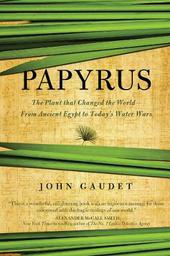
|
Papyrus: The Plant that Changed the World: From Ancient Egypt to Today's Water Wars
Paperback / softback
Main Details
| Title |
Papyrus: The Plant that Changed the World: From Ancient Egypt to Today's Water Wars
|
| Authors and Contributors |
By (author) John Gaudet
|
| Physical Properties |
| Format:Paperback / softback | | Pages:272 | | Dimensions(mm): Height 224,Width 142 |
|
| Category/Genre | Botany and plant sciences |
|---|
| ISBN/Barcode |
9781605988283
|
| Classifications | Dewey:584.84 |
|---|
| Audience | |
|---|
|
Publishing Details |
| Publisher |
Pegasus Books
|
| Imprint |
Pegasus Books
|
| Publication Date |
2 June 2015 |
| Publication Country |
United States
|
Description
From ancient Pharaohs to twenty-first century water wars, papyrus is a unique plant that is still one of the fastest growing plant species on earth. It produces its own "soil"-a peaty, matrix that floats on water-and its stems inspired the fluted columns of the ancient Greeks. In ancient Egypt, the papyrus bounty from the Nile delta provided not just paper for record keeping-instrumental to the development of civilization-but food, fuel and boats. Disastrous weather in the sixth century caused famines and plagues that almost wiped out civilization in the west, but it was papyrus paper in scrolls and codices that kept the record of our early days and allowed the thread of history to remain unbroken. The sworn enemy of oblivion and the guardian of our immortality, it came to our rescue then and will again. Today, it is not just a curious relic of our ancient past, but a rescuing force for modern ecological and societal blight.
Author Biography
John Gaudet, a professional ecologist has worked with the U.S. government and carried out research under grants from the National Geographic Society. As an ecologist and primary environmental advisor he is now a writer and consultant. His work has appeared in the Washington Post and he remains active in African, agricultural, and conservation/environmental agencies. John lives in northern Virginia. Visit his website at http://www.fieldofreeds.com.
Reviews"A versatile plant that has played a huge ecological and economic role, papyrus is brought into focus by John Gaudet in this outstanding book - a fascinating read, an enlightening story." -- Peter H. Raven, President Emeritus, Missouri Botanical Garden, St. Louis "This fascinating and beautifully written book is an absolute eye opener into the extraordinary world of papyrus. John Gaudet has a remarkable story to tell, and he tells it extremely well. This is a wonderful, enlightening book with an important message for those concerned with the fragile ecology of our world." -- Alexander McCall Smith, bestselling author of the No. 1 Ladies' Detective Agency "A fascinating account of the plant that provided the world with paper for the first four thousand years of its history. I learned a lot from this book, not only about papyrus but also about how wetlands can serve as filters for waste-water and how marshes and tropical swamps can help conserve valuable water. Lively and well written." -- Jean-Daniel Stanley, Senior Scientist Emeritus, National Museum of Natural History, Smithsonian Institution, Washington, D.C. "The hardy reed that stood at the center of ancient Egyptian civilization can foster sustainable growth in the 21st century, asserts ecologist Gaudet...The challenges are daunting, but Gaudet's detailed, undogmatic account of multiple attempts to counter overdevelopment with better practices inspires cautious optimism." -- Kirkus Reviews "One of the ways that papyrus changed the world was by providing the model, both structural and spatial, for the first temple complexes. The history of western architecture begins with the papyrus plant. John Gaudet tells a fascinating tale of the transmutation of vegetable into mineral, of graceful stems and umbels into the first stone columns, and of gladed swamps into sacred precincts. Architects and architectural historians should read this book and learn more about the beautiful and useful plant that inspired the earliest works of monumental architecture." -- Colin Davies, Former Editor of the Architects' Journal and Professor of Architectural Theory at London Metropolitan University
|